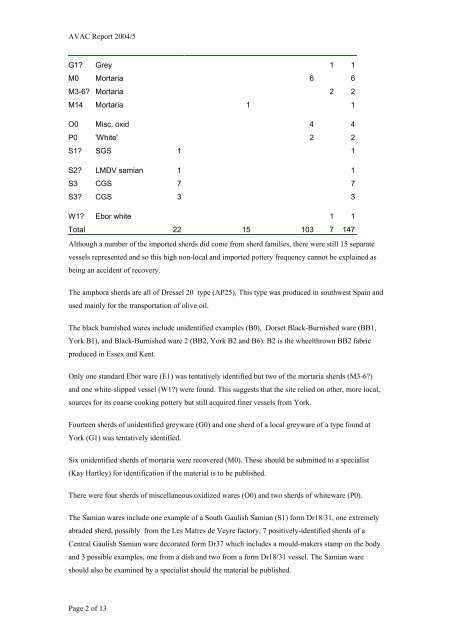Assessment of the Roman and later pottery from Nosterfield, North ...
Assessment of the Roman and later pottery from Nosterfield, North ...
Assessment of the Roman and later pottery from Nosterfield, North ...
You also want an ePaper? Increase the reach of your titles
YUMPU automatically turns print PDFs into web optimized ePapers that Google loves.
AVAC Report 2004/5<br />
G1? Grey 1 1<br />
M0 Mortaria 6 6<br />
M3-6? Mortaria 2 2<br />
M14 Mortaria 1 1<br />
O0 Misc. oxid 4 4<br />
P0 'White' 2 2<br />
S1? SGS 1 1<br />
S2? LMDV samian 1 1<br />
S3 CGS 7 7<br />
S3? CGS 3 3<br />
W1? Ebor white 1 1<br />
Total 22 15 103 7 147<br />
Although a number <strong>of</strong> <strong>the</strong> imported sherds did come <strong>from</strong> sherd families, <strong>the</strong>re were still 15 separate<br />
vessels represented <strong>and</strong> so this high non-local <strong>and</strong> imported <strong>pottery</strong> frequency cannot be explained as<br />
being an accident <strong>of</strong> recovery.<br />
The amphora sherds are all <strong>of</strong> Dressel 20 type (AP25). This type was produced in southwest Spain <strong>and</strong><br />
used mainly for <strong>the</strong> transportation <strong>of</strong> olive oil.<br />
The black burnished wares include unidentified examples (B0), Dorset Black-Burnished ware (BB1,<br />
York B1), <strong>and</strong> Black-Burnished ware 2 (BB2, York B2 <strong>and</strong> B6). B2 is <strong>the</strong> wheelthrown BB2 fabric<br />
produced in Essex <strong>and</strong> Kent.<br />
Only one st<strong>and</strong>ard Ebor ware (E1) was tentatively identified but two <strong>of</strong> <strong>the</strong> mortaria sherds (M3-6?)<br />
<strong>and</strong> one white-slipped vessel (W1?) were found. This suggests that <strong>the</strong> site relied on o<strong>the</strong>r, more local,<br />
sources for its coarse cooking <strong>pottery</strong> but still acquired finer vessels <strong>from</strong> York.<br />
Fourteen sherds <strong>of</strong> unidentified greyware (G0) <strong>and</strong> one sherd <strong>of</strong> a local greyware <strong>of</strong> a type found at<br />
York (G1) was tentatively identified.<br />
Six unidentified sherds <strong>of</strong> mortaria were recovered (M0). These should be submitted to a specialist<br />
(Kay Hartley) for identification if <strong>the</strong> material is to be published.<br />
There were four sherds <strong>of</strong> miscellaneous oxidized wares (O0) <strong>and</strong> two sherds <strong>of</strong> whiteware (P0).<br />
The Samian wares include one example <strong>of</strong> a South Gaulish Samian (S1) form Dr18/31, one extremely<br />
abraded sherd, possibly <strong>from</strong> <strong>the</strong> Les Matres de Veyre factory, 7 positively-identified sherds <strong>of</strong> a<br />
Central Gaulish Samian ware decorated form Dr37 which includes a mould-makers stamp on <strong>the</strong> body<br />
<strong>and</strong> 3 possible examples, one <strong>from</strong> a dish <strong>and</strong> two <strong>from</strong> a form Dr18/31 vessel. The Samian ware<br />
should also be examined by a specialist should <strong>the</strong> material be published.<br />
Page 2 <strong>of</strong> 13
















